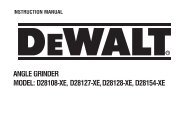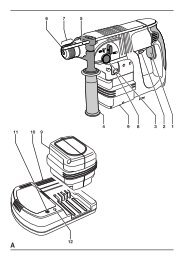Create successful ePaper yourself
Turn your PDF publications into a flip-book with our unique Google optimized e-Paper software.
90 mm height. For the proper cutting capacities, refer to the technical<br />
data. The length of the workpiece should never exceed the base<br />
width without adequate support. The end of the workpiece should<br />
never be less than 160 mm away from the blade without additional<br />
clamping means.<br />
- In operation, place your hands no closer than 160 mm from the<br />
blade. When cutting short material (min. 160 mm to the left or the<br />
right of the blade), the use of the optional material clamp is required.<br />
- The minimum length of offcut material is 10 mm.<br />
- When cutting workpieces longer than the table width, make sure that<br />
the workpiece is stable over its full length. Support the protruding<br />
parts of the workpiece as necessary, e.g. using the optional<br />
workpiece extension.<br />
- When cutting UPVC sections, a supporting piece made out of timber<br />
with a complementary profi le should be placed beneath the material<br />
being cut to provide the correct level of support.<br />
Vertical straight cross cut (fi g. A1 & P)<br />
• Release the mitre lever (10) and depress the mitre latch (9).<br />
• Engage the mitre latch at the 0° position and tighten the mitre lever.<br />
• Place the wood to be cut against the fence (6 & 13).<br />
• Take hold of the operating handle (2) and depress the head lock up<br />
release lever (3) to release the head.<br />
• Switch the machine on and allow the saw blade to reach full speed.<br />
• Depress the head to allow the blade to cut through the timber and<br />
enter the plastic kerf plate (8).<br />
• After completing the cut, switch the machine off and wait for the saw<br />
blade to come to a complete standstill before returning the head to its<br />
upper rest position.<br />
Performing a sliding cut (fi g. Q)<br />
The guide rail allows cutting larger workpieces using an out-down-back<br />
sliding motion.<br />
• Release the rail lock knob (17).<br />
• Pull the saw head towards you and switch the tool on.<br />
• Lower the saw blade into the workpiece and push the head back to<br />
complete the cut.<br />
• Proceed as described above.<br />
• Do not perform sliding cuts on workpieces smaller than<br />
50 x 100 mm.<br />
• Remember to lock the saw head in the rear position when<br />
the sliding cuts are fi nished.<br />
Cutting small pieces (fi g. K1 & K2)<br />
The upper part of the left side of the fence (13) and the moveable part of<br />
the right side of the fence (6) can be adjusted to provide maximum<br />
support when cutting small pieces.<br />
• Put the saw blade into vertical position.<br />
• Loosen the plastic knob (58) at least 3 full turns.<br />
• Adjust the left fence as close to the blade as possible.<br />
• Tighten the knob securely.<br />
• Loosen the wingnut (60).<br />
• Adjust the right fence as close to the blade as possible.<br />
• Tighten the wingnut.<br />
Vertical mitre cross-cut (fi g. A1 & R)<br />
• Release the mitre lever (10) and depress the mitre latch (9).<br />
Move the arm left or right to the required angle.<br />
• The mitre latch will automatically locate at 10°, 15°, 22.5°, 31.62° and<br />
45° both left and right, and at 50° left and 60° right. If any<br />
intermediate angle is required hold the head fi rmly and lock by<br />
tightening the mitre lever.<br />
ENGLISH<br />
• Always ensure that the mitre lever is locked tightly before cutting.<br />
• Proceed as for a vertical straight cross-cut.<br />
When mitring the end of a piece of wood with a small off-cut,<br />
position the wood to ensure that the off-cut is to the side of<br />
the blade with the greater angle to the fence:<br />
left mitre, off-cut to the right<br />
right mitre, off-cut to the left.<br />
Bevel cuts (fi g. A1, K1 & S)<br />
Bevel angles can be set from 48° left to 2° right and can be cut with the<br />
mitre arm set between zero and a maximum of 45° mitre position right or<br />
left.<br />
• Loosen the left side fence clamping knob (58) and slide the upper<br />
part of the left side fence (13) to the left as far as it will go.<br />
Loosen the bevel clamp handle (15) and set the bevel as desired.<br />
• Tighten the bevel clamp handle (15) fi rmly.<br />
• Proceed as for a vertical straight cross-cut.<br />
Compound mitre<br />
This cut is a combination of a mitre and a bevel cut.<br />
• Set the bevel angle and subsequently set the mitre angle.<br />
Sawing in the bench mode<br />
• Always use the riving knife.<br />
• Always ensure that the riving knife and blade guard are correctly<br />
aligned.<br />
• Always ensure that the mitre saw is set and locked in 0° mitre.<br />
Do not cut metal in this mode.<br />
Ripping (fi g. T)<br />
• Set the bevel angle to 0°.<br />
• Adjust the saw blade height. The correct blade position is to have the<br />
tips of three teeth above the top surface of the wood. Ensure that the<br />
saw bench table is securely fi xed at the chosen height.<br />
• Set the parallel fence to the required distance.<br />
• Hold the workpiece fl at on the table and against the fence. Keep the<br />
workpiece approx. 25 mm away from the saw blade.<br />
• Keep both hands away from the path of the saw blade.<br />
• Switch the machine on and allow the saw blade to reach full speed.<br />
• Slowly feed the workpiece underneath the upper blade guard,<br />
keeping it fi rmly pressed against the fence. Allow the teeth to cut,<br />
and do not force the workpiece through the saw blade. The saw<br />
blade speed should be kept constant.<br />
• Remember to use the push stick (73) when close to the blade.<br />
• After completing the cut, switch the machine off, allow the saw blade<br />
to stop and remove the workpiece.<br />
• Never push or hold the free or cut-off side of the workpiece.<br />
• Always use a push stick when ripping small workpieces.<br />
Optional accessories (fi g. A3 - A6)<br />
Clamping the workpiece (fi g. A3)<br />
• The action of the blade is suffi cient to hold the material fi rmly against<br />
the fence.<br />
• If the material has a tendency to lift or come forward from the fence,<br />
preferably use the optional material clamp (27).<br />
Support for long pieces (fi g. A4)<br />
• Always support long pieces.<br />
• For best results, use the extension work support (28) to extend the<br />
table width of your saw (available from your dealer as an option).<br />
35

















